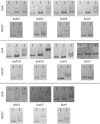Transcriptional control of lipid metabolism by the MarR-like regulator FamR and the global regulator GlxR in the lipophilic axilla isolate Corynebacterium jeikeium K411
- PMID: 23163914
- PMCID: PMC3917454
- DOI: 10.1111/1751-7915.12004
Transcriptional control of lipid metabolism by the MarR-like regulator FamR and the global regulator GlxR in the lipophilic axilla isolate Corynebacterium jeikeium K411
Abstract
Corynebacterial fatty acid metabolism has been associated with human body odour, and is therefore discussed as a potential target for the development of new deodorant additives. For this reason, the transcription levels of fad genes associated with lipid metabolism in the axilla isolate Corynebacterium jeikeium were analysed during growth on different lipid sources. The transcription of several fad genes was induced two- to ninefold in the presence of Tween 60, including the acyl-CoA dehydrogenase gene fadE6. DNA affinity chromatography identified the MarR-like protein FamR as candidate regulator of fadE6. DNA band shift assays and in vivo reporter gene fusions confirmed the direct interaction of FamR with the mapped fadE6 promoter region. Moreover, DNA affinity chromatography and DNA band shift assays detected the binding of GlxR to the promoter regions of fadE6 and famR, revealing a hierarchical control of fadE6 transcription by a feed-forward loop. Binding of GlxR and FamR to additional fad gene regions was demonstrated in vitro by DNA band shift assays, resulting in the co-regulation of fadA, fadD, fadE and fadH genes. These results shed first light on the hierarchical transcriptional control of lipid metabolism in C. jeikeium, a pathway associated with the development of human axillary odour.
© 2012 The Authors. Microbial Biotechnology © 2012 Society for Applied Microbiology and Blackwell Publishing Ltd.
Figures







Similar articles
-
The transcriptional regulatory network of Corynebacterium jeikeium K411 and its interaction with metabolic routes contributing to human body odor formation.J Biotechnol. 2012 Jun 15;159(3):235-48. doi: 10.1016/j.jbiotec.2012.01.021. Epub 2012 Feb 9. J Biotechnol. 2012. PMID: 22342369
-
Identification of McbR as transcription regulator of aecD and genes involved in methionine and cysteine biosynthesis in Corynebacterium jeikeium K411.J Biotechnol. 2011 Jan 10;151(1):22-9. doi: 10.1016/j.jbiotec.2010.11.005. Epub 2010 Nov 21. J Biotechnol. 2011. PMID: 21084057
-
Complete genome sequence and analysis of the multiresistant nosocomial pathogen Corynebacterium jeikeium K411, a lipid-requiring bacterium of the human skin flora.J Bacteriol. 2005 Jul;187(13):4671-82. doi: 10.1128/JB.187.13.4671-4682.2005. J Bacteriol. 2005. PMID: 15968079 Free PMC article.
-
Molecular basis of human body odour formation: insights deduced from corynebacterial genome sequences.Int J Cosmet Sci. 2012 Feb;34(1):2-11. doi: 10.1111/j.1468-2494.2011.00669.x. Epub 2011 Jul 25. Int J Cosmet Sci. 2012. PMID: 21790661 Review.
-
The RamA regulon: complex regulatory interactions in relation to central metabolism in Corynebacterium glutamicum.Appl Microbiol Biotechnol. 2018 Jul;102(14):5901-5910. doi: 10.1007/s00253-018-9085-3. Epub 2018 May 26. Appl Microbiol Biotechnol. 2018. PMID: 29804137 Review.
Cited by
-
Exploration of the role of the penicillin binding protein 2c (Pbp2c) in inducible β-lactam resistance in Corynebacteriaceae.Front Microbiol. 2024 May 9;15:1327723. doi: 10.3389/fmicb.2024.1327723. eCollection 2024. Front Microbiol. 2024. PMID: 38784795 Free PMC article.
References
-
- Auchter M, Cramer A, Hüser A, Rückert C, Emer D, Schwarz P, et al. RamA and RamB are global transcriptional regulators in Corynebacterium glutamicum and control genes for enzymes of the central metabolism. J Biotechnol. 2011;154:126–139. - PubMed
-
- Barzantny H, Brune I, Tauch A. Molecular basis of human body odour formation: insights deduced from corynebacterial genome sequences. Int J Cosmet Sci. 2012a;34:2–11. - PubMed
-
- Barzantny H, Schröder J, Strotmeier J, Fredrich E, Brune I, Tauch A. The transcriptional regulatory network of Corynebacterium jeikeium K411 and its interaction with metabolic routes contributing to human body odor formation. J Biotechnol. 2012b;159:235–248. - PubMed
-
- Brinster S, Lamberet G, Staels B, Trieu-Cuot P, Gruss A, Poyart C. Type II fatty acid synthesis is not a suitable antibiotic target for Gram-positive pathogens. Nature. 2009;458:83–86. - PubMed
Publication types
MeSH terms
Substances
LinkOut - more resources
Full Text Sources
Other Literature Sources
Molecular Biology Databases

